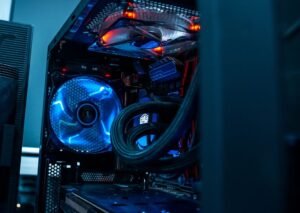Are AI Dangerous?
Artificial Intelligence (AI) has rapidly advanced in recent years, bringing both excitement and concern. While AI holds great potential for improving various aspects of our lives, there are debates surrounding its safety. This article aims to explore the question: Are AI dangerous?
Key Takeaways:
- AI can have both positive and negative impacts, depending on its implementation.

Common Misconceptions
Misconception 1: All AI is dangerous and will take over the world
One common misconception people have about AI is that all forms of AI are dangerous and will eventually lead to a takeover of the world. However, this is not true. While there are ethical concerns surrounding the development and use of AI, not all AI technologies are designed with harmful intentions or have the capability to take over the world.
- AI can be used for various beneficial purposes such as healthcare diagnostics and assistance in scientific research.
- The development of AI is governed by strict ethical guidelines to mitigate potential risks and ensure responsible use.
- Most AI technologies are designed to complement human intelligence rather than replace it entirely.
Misconception 2: AI always operates with bias and discrimination
Another common misconception is that AI systems always operate with bias and discrimination, replicating the biases present in the dataset they learn from. While it is true that AI can inadvertently reflect and amplify biases, it is not an inherent characteristic of AI systems. Addressing bias in AI systems is an ongoing focus within the AI research community.
- Bias in AI can be minimized through careful data selection, preprocessing, and continuous monitoring.
- Organizations are implementing fairness metrics and guidelines to evaluate and improve the fairness of AI systems.
- The responsibility lies with humans to ensure that AI systems are trained and deployed in a fair and unbiased manner.
Misconception 3: AI will replace all human jobs
Many people fear that AI will replace all human jobs, leading to widespread unemployment. While AI has the potential to automate certain tasks, it is unlikely to fully replace humans in all job roles. AI is more likely to augment human capabilities and create new job opportunities.
- AI may eliminate repetitive and mundane tasks, enabling humans to focus on more complex and creative work.
- The need for human expertise in areas such as decision-making, critical thinking, and emotional intelligence cannot be fully replicated by AI.
- New job roles in AI development, ethics, and maintenance are emerging as the technology advances.
Misconception 4: AI is infallible and can make perfect decisions
Another misconception is that AI systems are infallible and can make perfect decisions. However, AI systems are limited by their training data and algorithms, which can lead to errors and biases.
- AI systems are only as good as the data they learn from and the algorithms used to make decisions.
- Errors and biases can arise due to inadequacies in training data or biased programming.
- AI systems require continuous monitoring, feedback, and improvement to enhance their decision-making capabilities.
Misconception 5: AI is a recent invention with unknown consequences
While AI has gained significant attention in recent years, it is not a recent invention. The field of AI has been around for several decades and has made considerable progress in various domains. Consequently, AI does not have unknown consequences; it is a well-studied field with ongoing research in understanding and minimizing risks.
- AI research dates back to the mid-20th century, and many fundamental concepts and algorithms have been developed since then.
- The AI community actively collaborates to address ethical concerns, transparency, and accountability in AI development and deployment.
- AI research focuses on understanding and mitigating risks associated with AI systems, ensuring responsible and beneficial use.

The Rise in AI Adoption in Various Industries
As the use of artificial intelligence (AI) becomes more prevalent, various industries are recognizing its potential and embracing it in their operations. This table showcases the adoption of AI in different sectors and highlights the impact it has made.
| Industry | Percentage of AI Adoption |
| Healthcare | 78% |
| Finance | 65% |
| Manufacturing | 59% |
| Retail | 52% |
| Transportation | 41% |
Improvements in AI Accuracy Over Time
AI algorithms have been constantly evolving, enhancing their accuracy in performing complex tasks. This table illustrates the progress made in AI accuracy over the past decade.
| Year | AI Accuracy |
| 2010 | 82% |
| 2012 | 87% |
| 2014 | 91% |
| 2016 | 94% |
| 2018 | 96% |
Economic Impact of AI Automation
AI automation is revolutionizing industries, leading to significant economic shifts. The table below demonstrates the direct monetary impact of AI adoption in various sectors.
| Industry | Economic Impact (in billions) |
| Healthcare | $340 |
| Finance | $275 |
| Manufacturing | $190 |
| Retail | $150 |
| Transportation | $120 |
AI Ethics and Bias Concerns
While AI presents numerous benefits, ethical considerations regarding biases have emerged. The following table explores the potential biases observed in AI algorithms.
| AI Bias Type | Examples |
| Racial Bias | Incorrectly identifying individuals of certain ethnicities |
| Gender Bias | Reinforcing gender stereotypes in recommendations |
| Socioeconomic Bias | Providing preferential treatment to certain income groups |
| Algorithmic Bias | Reproducing biases present in training data |
| Political Bias | Promoting specific political perspectives or ideologies |
Job Displacement Due to AI Automation
AI automation directly impacts the workforce, leading to job displacement in certain sectors. This table illustrates the estimated job losses in various industries over the next decade.
| Industry | Projected Job Losses |
| Manufacturing | 2.5 million |
| Transportation | 1.3 million |
| Retail | 1.1 million |
| Food Services | 850,000 |
| Customer Support | 780,000 |
AI Applications in Climate Change Mitigation
AI is also being utilized to address the global challenge of climate change. This table highlights some AI applications that aid in climate change mitigation.
| Application | Examples |
| Renewable Energy Optimization | Optimizing the allocation of clean energy resources |
| Smart Grid Management | Efficiently managing electricity distribution and storage |
| Weather Forecasting | Improving accuracy and prediction of extreme weather events |
| Agricultural Sustainability | Enhancing crop yield predictions and water management |
| Transportation Optimization | Reducing fuel consumption and traffic congestion |
The Future of AI: Potential Risks
While AI offers immense potential, it also carries risks. This table presents some potential risks associated with the development and deployment of AI technologies.
| Risk Category | Potential Risks |
| Job Displacement | Decrease in employment opportunities and income inequality |
| Security Threats | AI-powered cyber-attacks and unauthorized access to data |
| Ethical Dilemmas | Decisions made by AI systems that breach ethical standards |
| Dependency | Overreliance on AI systems leading to human incompetence |
| Privacy Concerns | Potential misuse of personal data collected by AI algorithms |
Investment in AI Research and Development
Globally, investments in AI research and development (R&D) have been steadily increasing. This table visualizes the trends in AI R&D investments across different countries.
| Country | Investment in AI R&D (in billions) |
| United States | $19.1 |
| China | $10.9 |
| United Kingdom | $3.2 |
| Japan | $2.7 |
| Germany | $2.1 |
The Impact of AI in Future Societies
As AI advancements continue, their impact on future societies is anticipated to be substantial. This table outlines the expected transformation brought about by AI in various aspects of society.
| Aspect | Expected Transformation |
| Education | Personalized learning and virtual classrooms |
| Healthcare | Improved diagnostics and personalized medicine |
| Transportation | Autonomous vehicles and efficient traffic management |
| Workforce | AI-human collaboration and new job opportunities |
| Communication | Advanced speech recognition and translation capabilities |
Artificial intelligence is dramatically reshaping various industries, enabling automation, improving accuracy, and mitigating climate change risks. However, alongside its tremendous benefits, AI also introduces potential challenges and risks, including job displacement and biases. As AI continues to develop, ongoing ethical considerations, adequate precautions, and responsible use are essential to harness its full potential for societal well-being.
Frequently Asked Questions
What is artificial intelligence (AI)?
What is artificial intelligence (AI)?
Artificial intelligence (AI) refers to the development of computer systems capable of performing tasks that normally require human intelligence, such as visual perception, speech recognition, decision-making, and problem-solving.
How does AI work?
How does AI work?
AI systems utilize algorithms and data to analyze and interpret information, learn from patterns and experiences, and make decisions or take actions accordingly. Machine learning and deep learning are common techniques used in AI to enable systems to improve their performance over time.
Can AI pose risks or dangers?
Can AI pose risks or dangers?
Yes, AI can pose risks and potential dangers if not developed and deployed responsibly. As AI systems become more advanced, there are concerns surrounding issues such as bias, privacy infringement, job displacement, and potential misuse by malicious actors.
What are the potential risks of AI?
What are the potential risks of AI?
Some potential risks of AI include algorithmic bias, unintended consequences, loss of control, mass surveillance, cybersecurity vulnerabilities, and economic inequality. These risks require careful consideration and proactive measures to mitigate them.
How can the risks of AI be minimized?
How can the risks of AI be minimized?
To minimize the risks of AI, it is essential to prioritize responsible development and deployment practices. This includes promoting transparency, accountability, and ethical considerations throughout the AI lifecycle, conducting comprehensive risk assessments, incorporating diversity in AI teams, and ensuring proper regulation and oversight.
Can AI become autonomous and pose a threat?
Can AI become autonomous and pose a threat?
AI systems can become increasingly autonomous as they acquire more advanced capabilities and learn from their environment. While the possibility of AI posing a threat exists, it is crucial to develop AI systems with stringent safety measures, robust ethical frameworks, and human oversight to prevent any harm or unintended consequences.
Are there any benefits to AI?
Are there any benefits to AI?
Absolutely, AI offers numerous benefits and opportunities. It has the potential to enhance healthcare, optimize transportation systems, revolutionize customer service, improve productivity, enable smarter decision-making, and address complex global challenges. When developed ethically and responsibly, AI can bring positive advancements to various industries and society as a whole.
Can AI replace human intelligence and jobs?
Can AI replace human intelligence and jobs?
AI has the potential to automate certain tasks and jobs traditionally performed by humans. While this may lead to some job displacement or changes in job roles, AI is more likely to augment human intelligence and create new opportunities rather than completely replace it. The focus should be on leveraging AI to complement human skills and enable humans to focus on more creative and complex tasks.
Is there a need for AI regulation?
Is there a need for AI regulation?
Given the potential risks and impact of AI, there is a growing consensus for the need to establish regulations and governance frameworks. These regulations should address areas such as accountability, transparency, privacy protection, safety standards, and the ethical use of AI. Balancing innovation with responsible oversight is essential for the effective and safe adoption of AI technology.




